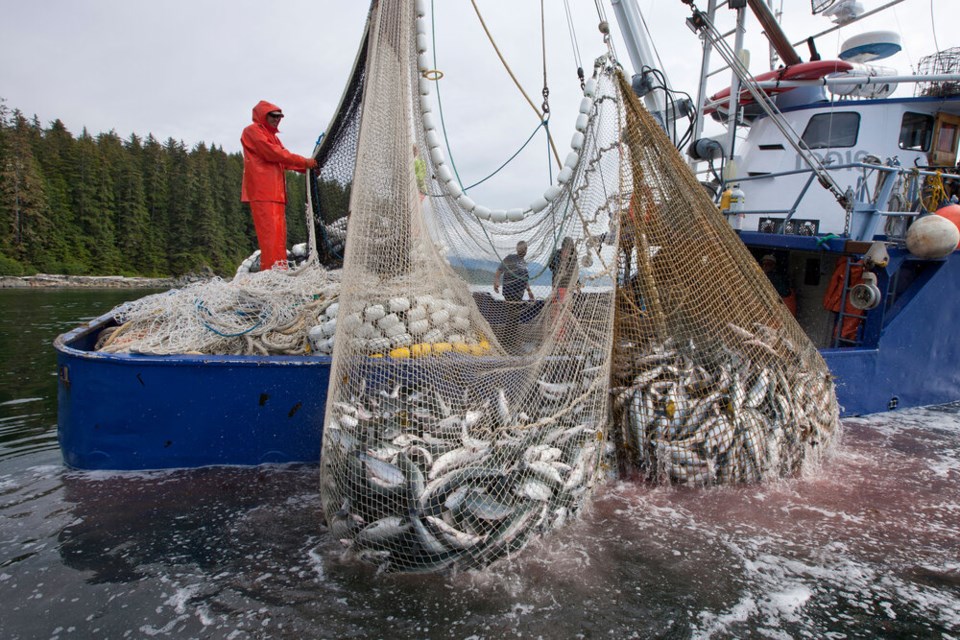Alaskan fishing fleets are catching a large proportion of the salmon bound for B.C. waters at a time many local fishers have been shut out of the industry, says a new study.
Of the almost 800,000 sockeye salmon caught in southern Alaskan waters in 2021, the majority came from Canadian rivers and streams, according to the technical study, , commissioned by Watershed Watch Salmon Society and SkeenaWild Conservation Trust.
Based on genetic data from previous years, Watershed Watch president Aaron Hill estimates up to 75 per cent of the approximately 800,000 sockeye salmon caught in southeast Alaska in 2021 were bound for B.C.'s north coast rivers. He says those details will be added to the report in the coming days.
Tens of thousands of Canadian-origin chinook and coho, and “a large but unknown number” of Canadian pink, chum and steelhead were also harvested, according to the report.
“We knew that the Alaskans were catching a lot of B.C. salmon, as they have for a long time, but it was pretty jarring to see how their share of the catch has grown as ours has dwindled to protect salmon,” said Hill.
If they could complete their journey, most of the salmon headed to B.C. would swim up the Skeena and Nass — the province's second and third most important salmon-bearing rivers. But many also would have carried on to the Fraser River or down the West Coast into other U.S. states.
Former Campbell River fishing captain Rick Frey used to have a licence near the mouth of the Nass River before he sold his boat a couple of years ago. Frey said while his boat would be fishing 12 hours a week, across the border, they could hear the radio chatter of Alaskan fishers as they pulled in their nets.
“We can hear them. They’re just across the border. They’re fishing five days a week. They’re catching our sockeye,” he said. “Those are our fish.”
B.C. salmon populations have plummeted to record lows in recent years. In response, the federal government closed 60 per cent of B.C.’s commercial salmon harvest in June 2021 and announced a fishing licence buy-back program under its $647-million Pacific Salmon Strategy Initiative.
Most of the B.C.-bound fish caught north of the border are intercepted on the south side of the Alaskan panhandle in Fishing District 104. According to the report, seine nets in District 104 catch 50 to 75 per cent of all Skeena sockeye caught in the southern reaches of Alaska, and between about 10 and 50 per cent of all Nass sockeye
As far as Fraser River sockeye intercepted in District 104, they can make up more than half of the total sockeye catch in late August. In 2019, the amount of Fraser River sockeye pulled out of Alaska’s southern waters exceeded that of Canada’s. That will likely happen again in 2021, notes the report.
It’s not just Canadian environmental groups raising the alarm. Hill said his group is working with the Wild Fish Conservancy out of Washington state, which is in the process of taking the U.S. government to court for its management plan of Alaska chinook salmon fisheries. Their concern is that chinook, a vital source of food for southern resident killer whales, are getting intercepted before the whales can feed on them.
In a dated Jan. 9, 2020, the group said it was suing the National Marine Fisheries Service for violations of the Endangered Species Act.
But for Canadian groups, such legal recourse against the U.S. government is more challenging. Many look to the Canada-U.S. Pacific Salmon Treaty to settle such imbalances, but it isn’t up for renewal until 2028.
Frey, who used to sit on a committee during past Canada-U.S. treaty negotiations, said the Canadian-bound fish plundered in Alaska were left as a kind of “freebie” while fair bilateral deals were worked out on the southern border.
“We could be fishing the hell out of their Washington and California stocks. And we’re not doing that,” Frey said.
Unlike in B.C., Alaskan fishers aren’t required to report their bycatch of non-target species and much of what gets thrown back lands in the water dead, said Hill.
Genetic tests so Alaskan fishers could avoid Canadian fish and third-party oversight to ensure bycatch makes it back in the water alive would be simple measures that could reap big benefits, said both Frey and Hill.
Among other recommendations, the report says Fisheries and Oceans Canada and the Alaska Department of Fish and Game should review existing assessment programs and design new ones to understand how fish are getting exploited in the region.
“We often wondered on the Canadian side why our fisheries isn't pushing to have more regulations from them,” said Frey of DFO's U.S. counterparts. “It’s so blatant. Why can’t they do anything about it?”
Both the environmentalist and former fisher said it’s time for the Canadian and B.C. government to exert whatever pressure they can on Alaskan fisheries to clean up their act.
“The Alaskans need to shut down this dirty fishery. It only exists to intercept B.C. salmon migrating through their waters,” said Hill.
“It’s incredibly unfair and wrong that Canadian fishers and taxpayers are taking it on the chin to save the fish while across the border the Alaskans are beating the hell out of them.”






